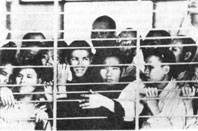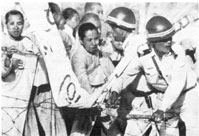Chapter 10
The Promotion of Catholic Totalitarianism
Having consolidated the State machinery with loyal Catholics, and feeling sure of their loyalty, not to mention of the tacit and indeed active support of his protector, the U.S., Diem took the second step to make his dream come true. He undertook a systematic and well calculated policy against the non-Catholic religions.
His policy was directed at the neutralization, disruption and finally elimination of the Buddhists or Buddhist inspired religions of Vietnam. These sects, many opposing each other on religious and political grounds, could nevertheless equal, and indeed effectively oppose any Catholic administration, had they created a united front.
Diem's policy was a subtle one. He encouraged their dissension. This he did by giving bribes, by sending agents in their midst, by promising official protection, and by denying the same to others. The result became apparent in no time. The religious sects fell into the Diem trap. They began to fight one another with increasing bitterness. This culminated with the internecine religious-political feud, between the Binh Xuyen, and the Hao Hao and the Cao Dai groups. Their enmity was not only religious, it was concretely real. Their battle was a bloody one. At one time various quarters of Saigon itself were devastated. The Buddhists set up a committee to give aid to the victims. Diem suppressed them at once.
The struggles between the opposing religious-political rivals gave a sound excuse to Diem to do what he had in mind long ago. He set about to arrest the leading members of the hostile religions. The arrests eliminated the most potentially dangerous of his opponents. As a result, in due course opposition from the religious quarter had almost vanished.
Having made sure that the indigenous religious political opponents had been neutralized, Diem then took a further step, the consolidation of his political power. To that effect, he organized a referendum and replaced Bao Dai, who until then, had been the official head of government. Thereupon he proclaimed a Republic of Vietnam. Having succeeded in this, on October 22, 1955, he became or rather he made himself its president.
The next year, October 26, 1956, he promulgated a new Constitution. Imitating Mussolini, Hitler, and also Ante Pavelich of Catholic Croatia, (not to mention Franco of Catholic Spain, and Salazar of Catholic Portugal,) he inserted an article, Article 98, which gave him full dictatorial powers. The article read in part as follows: "During the first legislative term, the president (that is Diem) may decree a temporary suspension of . . . (there followed almost all the civil liberties of the nation) to meet the legitimate demands of public security, etc." The article should have expired in April, 1961, but it was maintained indefinitely.
Buddhist monks and nuns in a concentration camp outside Saigon. The Buddhists behind bars were arrested after a demonstration against the government, when President Diem issued laws grossly discriminating against the Buddhists and the Buddhist religion. They were arrested by the hundreds and sent to detention camps, where many of them were ill-treated. At one time, thousands of monks and nuns were behind bars. The anti-Buddhist discriminatory regulations of Diem divided the country into denominational lines, with the result that the effectiveness of the war was seriously impaired. Thousands of Buddhists started passive resistance against the Diem regime, while thousands of Buddhists in the army refused to fight for a government which was persecuting their religion. |
But even more dangerously ominous was a decree that Diem had issued before that. In January, 1956, he had already promulgated a personal presidential order, which was already portending the shape of things to come. The Order 46, read as follows:
Individuals considered dangerous to the national defense and common security may be confined by executive order, to a concentration camp.
Although, some American "advisors" had blinked at the decree, it was taken for granted. They were mere threatening words. Others, however, knew they were meant to be preparatory measures to be taken once the transformation of South Vietnam into a total Catholic State started to be put into force.
The campaign began with a mass denunciation of communism. That is, it was given a purely ideological undertone. It was officially called "The Anti-Communist Denunciation Campaign." The operation was acceptable and, in view of the circumstances, was even a plausible one. Yet, behind its facade its real objective was the Catholicization of the country. It was McCarthyism transplanted into Vietnam. The campaign, in fact, had been inspired and promoted by the same elements which had supported McCarthyism in the U.S. Chief amongst these were the Kennedy brothers, Mr. Richard Nixon, Cardinal Spellman and certain factions of the CIA.
The Vietnamese McCarthyism turned even more vicious than its American counterpart. It was brought down to street and denominational levels. Sections of villages denounced other sections because they were not as Catholic as themselves, under the excuse that they were not as anti-Communist. Students, and indeed children, were encouraged to denounce their parents. School teachers instructed their pupils to listen and to report members of their families who criticized either Diem or the bishops, or the Catholic Church. Parents, grandparents, professors, monks, Buddhists were arrested without any warrant
Steel-helmeted combat police pull down a Buddhist banner and attempt to encircle Buddhist monks and nuns with barbed wire. More than one thousand monks and nuns attempted to escape the barbed wire wall which the police had erected to separate them from a large crowd of Buddhist demonstrators. Many tried to crawl under the barbed wire, but the police beat them back. Even so, many were arrested while others managed to demonstrate in spite of the police brutality. Such scenes became almost a daily occurrence as the discrimination against the Buddhists continued to escalate. It was reckoned that at one time more than one third of the Buddhist population of monks and nuns were detained, confined or otherwise deprived of their liberty. |
or legal formalities. Soon searches and raids were organized in a systematic scale all over South Vietnam. A fearful pattern came quickly to the fore: denunciations and arrests of suspects, interrogations by the police, regroupings, the encirclements of whole villages, the disappearance of individuals, without leaving any trace . Brutal interrogations, deportations, and indiscriminate tortures were used wherever those arrested did not cooperate in denouncing others.
The jails were soon bursting with prisoners. The mass arrests became so numerous that finally it was necessary to open detention camps followed by additional ones euphemistically called internment camps. The reality of the matter being, that they were veritable death camps. To mention only one by name, that of Phu Loi, Thu Dai Mot province, where there occurred a mass poisoning of more than 600 people, there were over 1000 dead.
There followed massacres within and outside such detention sites, like those which took place at Mocay, Thanhphu, Soctrang, Canginoc, Dailoc, Duyxuyen, to mention only a few. Religious sects and racial minorities were persecuted, arrested and whenever possible eliminated. To save themselves from arrest or even death many detainees had to accept the religion, language and customs of the new South Vietnam, as did the minority of Chinese and the Khmer, whose schools were closed down. Minor groups were exterminated or accepted the Catholic Church to save their lives.

